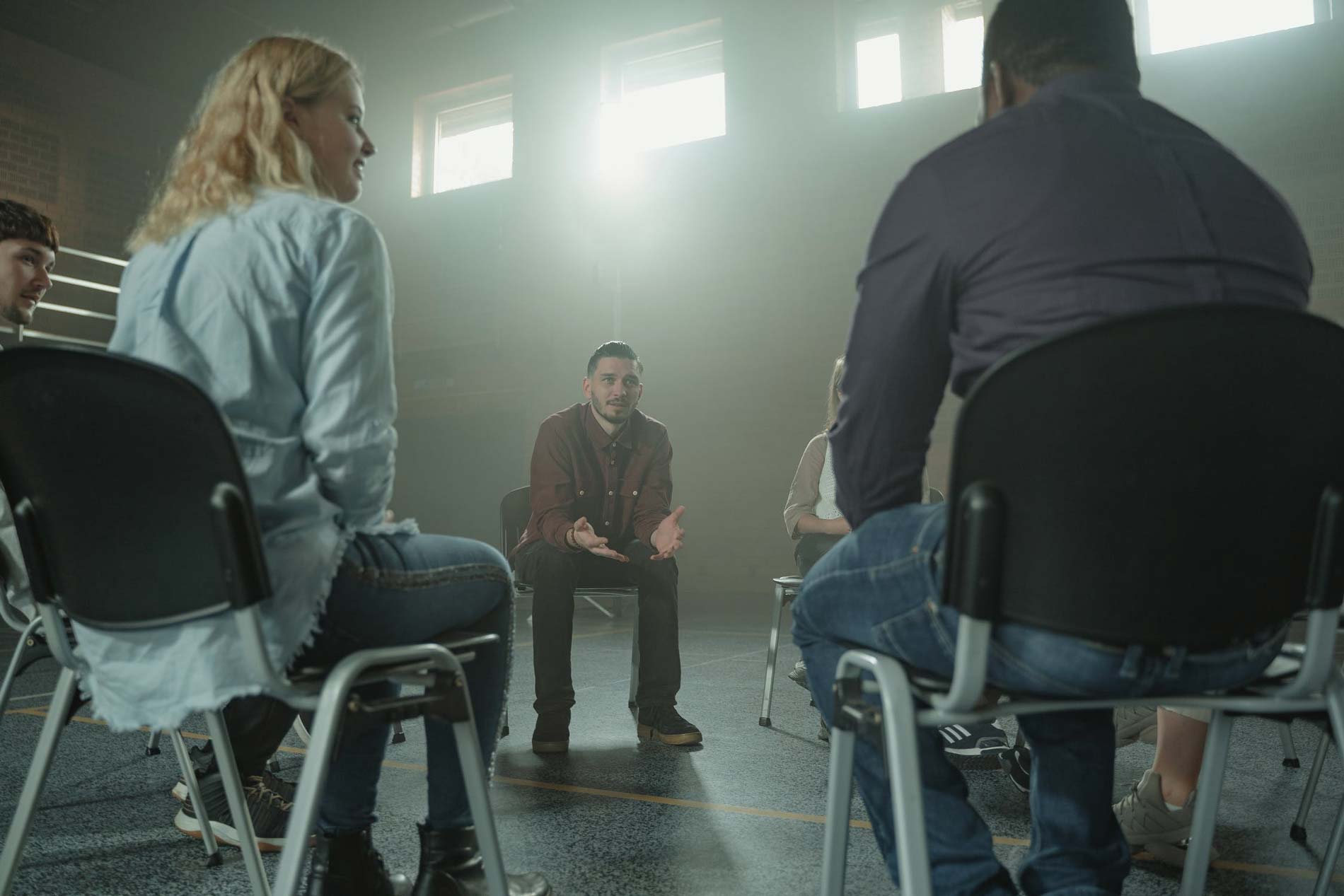Why Your Failed New Year's Resolution Deserves a Second Chance
Now that we’re one month into 2015, many of you will have thrown in the towel on your New Year´s Resolution. Some of you might not have set one at all, while others of you were going strong for the first two weeks and then “fell off the wagon” in mid-January. If you´re one of the many people who haven’t been able to stick to whatever plan you had in mind, you might be feeling “lazy,” “unmotivated” or even considering whatever resolution you had in mind to be a “lost cause.”

However, what if the fact that you weren’t able to follow through with your goals was related to where you stand in what psychologists refer to as “The Stages of Change¨ model? Would you be able to treat yourself and your supposed “failure” with a more compassionate attitude? And would you possibly consider jumping back on that wagon and starting again? Let’s take a look…
- Precontemplation: In this stage you may have heard from others that you ought to make a change, but you´re not actually considering doing anything about it.
- Contemplation: You´re considering making a change and imagining what it might be like if you did make that change.
- Preparation: You´ve started gathering information and support and are almost ready to take the first steps.
- Action: You´ve taken the first steps to put your plan into action.
- Maintenance: You´re in this stage when you have been diligent at carrying out actions that you had committed to for at least six months.
DeClemente and Prochaska’s Stages of Change Model has been largely used in the field of addictions for understanding why some people are able to stop drinking or using drugs, while others stay stuck in a standstill. Many therapists, including myself, have also found this model to be helpful when working with patients with Eating Disorders. These patients are notorious for having poor treatment outcomes, which can be really frustrating for those professionals trying to treat them, as well as the families and the patient’s themselves. However, by stepping back and asking these patients, “how ready are you to change?” the apparent resistance to treatment can be seen for what it really is: that the patient is not ready to change, yet.
And that word «yet», holds in it one of the keys to this model. It allows you to see that whatever stage you are currently at is only temporary and therefore advancing towards your goals is a matter of identifying what you need to help you increase your readiness to change and therefore advance to the next stage. Another important aspect of this model is that it normalizes «falling off the wagon.» It acknowledges that behavior change is more often than not a nonlinear process meaning we often must take «two steps forward, one step back» in order to advance towards our goals.
The Stages of Change Model is not only reserved for such serious problems as the treatment of drug addiction and Eating Disorders. It can be applied to anyone interested in making a change in their lives, whether it is to procrastinate less, go to the gym more or wake up without hitting the snooze button so many times.
What New Year’s Resolution did you set for yourself this year? Or wish you had set for yourself? Take a look at the model above and ask yourself what stage you´re at in relation to this resolution. Working with a therapist can help you to identify where you are, what is blocking you from moving forward and together you can work to create a personalized plan to help you work towards giving your New Year’s Resolution the second chance it deserves this year.
Sinews MTI
Psychology, Psychiatry and Speech Therapy
El estrés laboral: un problema generalizado. Una solución compleja
El estrés laboral es un fenómeno generalizado en nuestra sociedad que se ha acentuado aún más desde el inicio de la crisis económica. La precariedad laboral, los salarios menguantes y la perdida de empleo o el desempleo han hecho que se disparen los porcentajes de trabajadores que lo sufren.
Es verdad que cierto nivel de estrés puede ser adaptativo e incluso puede llegar a motivar, aumentar nuestro rendimiento, y conseguir que llevemos una vida más estimulante, pero muchas veces, cuando sobrepasamos este umbral, el estrés nos acaba agotando, y repercute muy negativamente sobre nuestro rendimiento y nuestra salud.
El coste económico es enorme pero generalmente las empresas o las organizaciones están poco dispuestas a tomar medidas que reduzcan sus efectos si eso implica tener que modificar sus procedimientos o pensar en el bienestar del trabajador.
Algunas de las medidas que las organizaciones podrían tomar para reducir los niveles de estrés en sus empleados están ya tipificadas:
- Establecer horarios de trabajo que eviten conflictos con las exigencias y responsabilidades externas ( en definitiva ser mas flexibles ).
- Fijar cargas de trabajo compatibles con las capacidades del trabajador y permitirle recuperarse después de periodos más exigentes.
- Permitir el uso de las capacidades personales de cada trabajador para lograr que su realización sea más estimulante.
- Evitar la ambigüedad en relación al futuro ( estabilidad laboral y el fomento de progresión laboral).
- Diseñar adecuadamente las condiciones del puesto de trabajo ( ambiente físico, capacitación adecuada ).
- Fomentar la comunicación fluida dentro del entorno de trabajo ( entre iguales y a distintos niveles ).
- Permitir la participación en la toma de decisiones.
- Definir claramente las funciones y tareas a realizar.
- Apoyar socialmente desde dentro de la organización a sus empleados.
Sin embargo, en las condiciones actuales del mercado laboral, estas medidas no dejan de ser un compendio de buenas intenciones con difícil implementación real.
¿Debemos pues renunciar a intentar vivir menos estresados en el trabajo? La respuesta es claramente no. Podemos y debemos controlar nuestros niveles de estrés a pesar de no poder contar con la plena colaboración de las organizaciones.
¿Pero, cómo hacerlo? Hemos de focalizar nuestros esfuerzos en aquello que está bajo nuestro control y sobre lo que podemos actuar: es decir, nosotros mismos.
Por último, me gustaría recomendar dos películas que aun siendo muy distintas, las dos tratan este tema y nos pueden ayudar a reflexionar sobre nuestra capacidad para modificar nuestro entorno: “¡Que Bello es Vivir!” (“It´s a Wonderful Life”)” y “Cadena de Favores” (“Pay it Forward”).
La primera es un clásico de Frank Capra, protagonizada por James Stewart y Donna Reed de 1946. En ella se cuenta la historia de un hombre que contempla cómo hubiera sido la vida de los que le rodean si él no hubiera existido…
La segunda es una película del año 2000 dirigida por Mimi Leder con Kevin Spacey y Helen Hunt que narra cómo un niño de 12 años piensa y pone en práctica un método que sirve para mejorar el mundo con la ayuda de la simple determinación y la voluntad de cada persona.
Cuando nos vemos agobiados por el trabajo, tenemos tendencia a dejar de lado toda una serie de hábitos saludables que nos protegen frente al estrés:
- ejercicio regular,
- patrón del sueño adecuado,
- alimentación equilibrada,
- relaciones sociales gratificantes y
- actividades de ocio
y por el contrario adoptamos toda una serie de hábitos negativos:
- aumenta o se inicia el consumo de tabaco, alcohol y otras sustancias nocivas para la salud,
- aumenta el consumo de medicación,
- se come en exceso
Cuando el estrés se sufre de forma prolongada, pueden incluso aparecer diversos problemas de salud como:
- dolores de cabeza
- problemas cardiovasculares
- problemas digestivos
- problemas sexuales
- agotamiento físico
- insomnio
La depresión, la ansiedad, y el debilitamiento del sistema inmunológico son también consecuencias de un estrés prolongado e intenso.
Para prevenir y tratar este tipo de problemas tenemos que hacer un esfuerzo consciente para mantener y/o mejorar nuestros hábitos de salud general. Pero además de estos hábitos, podemos mejorar nuestros recursos y aprender nuevas habilidades para el manejo del estrés.
En primer lugar, es importante aprender a identificar los estresores que nos afectan y cómo lo hacen. De esta forma descubrimos patrones inadecuados y nos damos cuenta de sus efectos.
Además, el uso adecuado y permanente de distintas técnicas de relajación (respiración profunda, relajación muscular progresiva ) tienen un impacto directo sobre nuestro nivel de activación y nos ayudan a controlar mejor nuestro cuerpo. La reestructuración cognitiva nos ayuda a reformular y reinterpretar las situaciones y nos ayudan a cambiar de actitud. Otras técnicas como las auto-instrucciones, la solución de problemas, el control de la ira, y detención del pensamiento nos dotan de herramientas para aumentar nuestro auto-control.
El aprendizaje y/o la mejora de nuestras habilidades sociales también servirá como apoyo y nos protegerá frente a las demandas del ambiente.
Si a pesar de todos estos esfuerzos, no conseguimos controlar nuestros niveles de estrés, no debemos renunciar a sentirnos mejor y debemos buscar la ayuda de un profesional.
En definitiva, la valoración que hace la persona de las situaciones estresantes es muchas veces más importante que las características objetivas de dichas situaciones y si adoptamos hábitos que nos mantengan sanos y aprendemos a manejar esos estresores, veremos como controlamos mejor nuestras respuestas y vemos reducido el impacto negativo de dichas situaciones.
El estrés laboral tiene pues un gran impacto en nuestra sociedad y sus repercusiones se notan a muchos niveles. Afecta no solo al bienestar físico y psicológico del trabajador, sino que tiene un gran coste a nivel organizacional. La solución a este problema pasa necesariamente por un cambio estructural en la concepción y el funcionamiento del mercado laboral. Sin embargo, este cambio se antoja todavía lejano. Hasta entonces, no debemos renunciar a vivir más tranquilos y por ello hemos de centrar nuestros esfuerzos en modificar todos los aspectos que si están bajo el control particular de cada individuo. Esto requiere esfuerzo, constancia y mucha voluntad, pero los beneficios valen la pena. Es nuestra vida la que está en juego.
Sinews MTI
Psychology, Psychiatry and Speech Therapy
Is Self-Compassion More Important Than Self-Esteem? by Steven Hayes
Self-esteem for the last 20 years was considered the rock of success in life. You can´t possibly get ahead in life, unless you believe you are perfectly awesome. And obviously you need to be perfectly awesome to keep believing it. So you end up living in terror of making mistakes, and feeling devastated when you do. Is this the best way to approach success?
This article by Steven Hayes raises very important questions. Questions such as: How important is self-esteem? How important does our culture belive it to be? Does our performance depend on it as much as we believe? Why could it be problematic to try to raise my self-esteem? What is self- compassion?
Self compassion understood as treating oneself kindly, recognizing one´s struggles as a part of shared human experience and becoming aware of painful thoughts and feelings feels like a right direction.
And since it´s New Years Resolution time, why don´t we pursue what could really make our life better.
Happy New Year!
https://www.huffingtonpost.com/steven-c-hayes-phd/is-selfcompassion-more-im_b_6316320.html
Sinews MTI
Psychology, Psychiatry and Speech Therapy
Learning to Listen, Listening to Learn: Building Essential Skills in Young Children

Learning to Listen, Listening to Learn: Building Essential Skills in Young Children – 2008 by Mary Renck Jalongo
This book can be a valuable resource for parents or educators interested in language development.
As we know, hearing and listening are not the same thing. We constantly hear different noises around us, but listening is an active process where we actually need to analyse and integrate what we hear. It is very important for children to develop active listening skills like this in turn will help them to develop their general language abilities.
A child’s listening skills depend on a number of different auditory competencies such as determining the direction from which a sound comes, recalling or memorising auditory information, the intonation of voice and being aware of rhythmic patterns. All this provides the basis for the development of expressive language and is important in the acquisition of vocabulary and early literacy.
Some strategies to train children´s listening skills are:
- Get down to the child’s level and make eye contact.
- Give a child your full attention. When you stop what you are doing and just listen, you lower the number of distractions and become a good model for your child to copy.
- Play guessing games with musical instruments or using other environmental noises such as animals or vehicle noises for example.
- Read stories aloud and when the child knows the story ask them to act it out while you are telling it. This activity can be great fun for everybody
- Always praise and reward your child for good listening strategies and for responding to instructions.
If you are interested in obtaining further insight and learn detailed activities you can put into practice, this book provides an easy and practical guide to improve your child´s early listening skills. A child can quickly improve through play and training in an aspect which will certainly help them academically and personally in the future.
Sinews MTI
Psychology, Psychiatry and Speech Therapy
La cura de Yalom

Uno de los psicoterapeutas que me ha inspirado en mi vida personal y por consiguiente también influido en la forma de trabajar con mis pacientes es Irvin Yalom. Admiro mucho su trabajo y su obra, por eso me produjo mucha ilusión saber que se ha realizado una película- documental sobre su persona: Yalom´s cure.
“Irvin D. Yalom, psiquiatra reconocido a nivel mundial y autor de numerosos best-sellers, es considerado como el psicoterapeuta más prominente de Estados Unidos. Se han vendido millones de ejemplares de sus libros en el mundo entero, y tanto los críticos como el público lector consideran sus obras como un tesoro que es capaz de devolverles la luz a aquellos que la han perdido desde hace mucho tiempo. Sus libros se han transformado en verdaderas guías para comprender y aceptar nuestros defectos, nuestro lado negativo. Yalom’s Cure es más que una película biográfica. Su fuerza radica en hacer universales las inquietudes que, a simple vista, parecen ser íntimas e individuales. La directora de cine Sabine Gisiger nos ofrece un recorrido a través de la vida de este hombre fuera de lo común, con respeto y pudor, mostrando a la figura pública, pero también dejando ver su “yo” interno, su vida espiritual. La realizadora suiza nos revela con ingenio la complejidad de esta dicotomía entre imagen profesional y vida privada (su rol como esposo, padre y guía espiritual), y logra seducirnos haciéndonos olvidar el presente y llevándonos a un mundo donde la temporalidad no existe.
La voz serena y profunda de Yalom nos cobija y nos tranquiliza, llevándonos, sin que nos demos cuenta, hacia nuestro inconsciente, enfrentándonos a problemáticas existenciales que, por lo general, preferimos ignorar ya sea por miedo, por comodidad o simplemente por la vida frenética que llevamos y que nos hace insensibles hacia el mundo y hacia nosotros mismos. Gracias a su último largometraje, Sabine Gisiger nos propone una especie de psicoanálisis a través del cine. Nos permite, por un pequeño y valioso momento, confrontar nuestra intimidad llena de angustias, deseos y sueños. Irvin Yalom nos enseña hasta qué punto estos miedos, que nosotros creemos que solamente son nuestros, en realidad son universales, y nos hace ver la importancia de afrontarlos para lograr vivir en paz (o al menos de forma más tranquila) con los que nos rodean, y sobre todo con nosotros mismos. ¿Acaso la magia del cine no radica justamente en abrirnos ventanas hacia el mundo; en hacernos reflexionar acerca de la sociedad y de nuestras inquietudes íntimas?”
Este es el trailer de la esperada película https://yalomscure.com/
Deseando que se estrene pronto.
Sinews MTI
Psychology, Psychiatry and Speech Therapy
Yalom´s Cure. Eine Anleitung zum Glücklichsein

Ich nehme an, dass Irvin D. Yalom und/oder seine Bücher vielen von Ihnen ein Begriff sind. Er ist Psychiater, Psychoanalytiker und Psychotherapeut und hat sowohl psychotherapeutische Lehrbücher, als auch Romane veröffentlicht. Sein Werk hat mich auf persönlicher Ebene inspiriert und gleichermaßen die Art mit meinen Klienten zu arbeiten beeinflusst.
Aus diesem Grund habe ich mich sehr gefreut als ich erfuhr, dass ein Film über ihn und mit ihm gedreht wurde. Diesen Film schätze ich als sehr Empfehlenswert ein und hoffe, dass er bald in die spanischen Kinos kommt.
“Der 80-jährige Psychiater und Bestseller-Autor Irvin D. Yalom gilt als der einflussreichste Psychotherapeut der USA. Er hat weltweit Millionen von Büchern verkauft. Kritiker beschreiben ihn als inspirierend, fesselnd und lebensverändernd. Sein Werk betont den Wert von Beziehungen und dreht sich um die Frage, wie Therapie funktioniert. Der Film «YALOM’S CURE» von Sabine Gisiger bietet mehr als eine klassische Biographie: Yalom nimmt das Publikum mit auf eine existentielle Reise durch die vielen Schichten der menschlichen Psyche. In der Rolle des Reiseleiters teilt Yalom seine Einsichten und gewährt tiefe Einblicke in sein eigenes Seelenleben.”
Unter https://yalomscure.com/ kriegt man einen guten Eindruck.
Viel Vergnügen.
Sinews MTI
Psychology, Psychiatry and Speech Therapy
Lenguaje y emoción: ¿Por que mi hijo no quiere hablarme en uno de sus idiomas?"
Aqui transcribimos la consulta de una familia de expatriados españoles a nuestra especialista en bilingüismo, Dra. Mariana Lombardo.
Question
Somos una familia de españoles viviendo en Alemania, o sea que mi hijo se está educando en un ambiente bilingüe, con nosotros sólo español y fuera alemán. Tiene 4 años y habla alemán de acuerdo con su edad, según la valoración de la guardería, pero no quiere hablarlo delante mio. ¿Es una reacción normal? ¿A qué puede ser debido? ¿Me debo preocupar? Gracias,
Answer
Querida mamá,
En primer lugar, y para que desde ya te quedes totalmente tranquila, es un comportamiento muy habitual, ya que, según planteas en tu consulta, con mama y papa solo ha hablado español desde siempre.
Los idiomas, además de comunicar hechos, necesidades y sentimientos, permiten establecer un vínculo con un otro. Y este vínculo, es muy difícil de modificar, ya que lleva implícita mucha carga emocional.
Imagínate a ti misma queriendo ahora hablar con tu madre en Italiano cuando siempre lo has hecho en español (imagina que ambas dominan el italiano, claro está). Sería raro, difícil, y hasta algo incómodo. Sería como estar hablando con otra persona que no es tu madre. Más o menos esto es lo que les pasa a los niños. Y no es algo consciente, es algo «que sale» naturalmente. Contigo tu hijo se siente cómodo hablándote en español y no le encuentra ningún sentido a cambiar al alemán. Como papas nos sentimos orgullosos de todo aquello que saben y pueden ir logrando nuestros hijos y pareciera que queremos demostrarlo y demostrarnos eso todo el tiempo, pero los niños lo viven de otra manera, sobre todo lo viven de manera natural y, desde luego, no le encuentran sentido a modificar ciertas conductas «porque si».
Así que, adelante con el proyecto que de seguro sale fenomenal y a seguir disfrutando de tu pequeño por sobre todo!
ARTICULO: Para profundizar en el tema y entender un poco más sobre el lenguaje y las emociones, este artículo nos relata un claro ejemplo de cómo los niños lo tienen clarísimo y así lo demuestran. Enjoy it!
https://www.psychologytoday.com/blog/life-bilingual/201102/the-person-language-bond
Sinews MTI
Psychology, Psychiatry and Speech Therapy
Psychologist on the inside...
Interview with Lidia Budziszewska, Psychologist, questions asked by:
Cathy Smitton, Speech and Language Therapist.
What funny things do people ask you about your profession?
People ask many things, concerning both my professional and private life. The most common are:
• » Do you always analyze/psychoanalyze anyone you meet? «
• «Are you sometimes tired of listening to all those people? «
• «Does a psychologist need a psychologist? «
• «Do I have to lie down on the coach? «
• «Can I tell you about my dreams? «
Why do you think people ask those questions?
Our profession is awakening those questions because people are unaware of what we do as professionals, of what to expect from us. A need to categorize and understand reality is one of the most important human needs. This is exactly how stereotypes are born…
What stereotypes exist about your profession?
I can only guess how many 🙂 Still the most common ones are
• Counsellors and therapists use too much “psychobabble.”
That´s a common concern, and certainly a very important issue for health professionals who need to be able to clearly explain how the mind, behaviour, or relevant topic works. We learn to use a simple, friendly language in order to be able explain all that to our clients or anyone interested in our profession.
• We are all-knowing and can provide all the right answers.
That´s another expectation and a hard one to redirect.
It is common to get asked “What should I do?”, “What’s the answer to this problem?”, “What do you suggest?”. It would be nice if someone could tell us exactly what to do in order to feel better or get to the next step in life, but those answers lie within us. The professional helps us find them.
• We must have perfect lives.
If this one were true, the therapist wouldn´t be able to understand us, and relate to us. This raises the question of whether the objective of therapeutic intervention is perfection? Or finding a way to enjoy the life we have, making changes in the way we live?
We do have normal lives, perhaps more aware and conscious of our behaviour, but as anyone else, full of mistakes and errors, disappointments, bad and good days.
How do you respond to those stereotypes?
Obviously it depends on who´s asking and in what context. If it´s a question, a joke between friends, I can just laugh about it with no need to clarify.
But if it´s a client asking and you can sense a more serious concern behind the question, I try to address the issue the best I can.
What would you like people to know about your profession?
That it´s very complex, demanding and hard work but also fascinating, encouraging continuous learning and motivation – as any other job can be, if you feel that what you´re doing makes sense.
Soon find out our Interview with Cathy Smitton, our Language and Speech Therapist
Sinews MTI
Psychology, Psychiatry and Speech Therapy
What is bullying, why does it happen and how can we help our children?
When we hear the word “bully”, the usual visual picture of an older kid picking on a smaller or younger child appears in the mind. This is most certainly true, but bullying encompasses much more than that.
So, when does bullying start and what is it really about?
Actually bullying starts as soon as kids begin to socialize. So, research indicates that bullying behaviour can start as early as age 3. While it's hard to know exactly why some children become bullies and others don't, there is evidence to suggest that some children are genetically predisposed toward being aggressive. Research also shows that children who are exposed to aggression on a consistent basis may imitate the behaviour they observe. Most children learn to control their anger and fighting instincts, as they grow older, but not the bully.
You feel identified? If so, this is what you can do.
Bullying can consist of any action that is used to hurt another child repeatedly and without cause (Olweus, 1993). In order for a bullying situation to occur there must be three conditions present:
First, there is a desire, on the part of the bully, to inflect some kind of physical or emotional pain.
Second, there must be a difference in power between the individuals involved, whether it is physical power, or the power to exclude another from the social grouping.
Third, the behaviour should be repeated.
As parents, if we want to know if our children are being bullied, we should first know the different forms it can have. There are different types of bullying:
- Physical: the most commonly known forms include hitting, kicking, tripping/pushing, making mean or rude hand gestures, spitting, pushing, and taking personal belongings.
- Verbal: includes taunting, malicious teasing, name-calling, inappropriate sexual comments, threatening to cause harm and making threats.
- Psychological: involves spreading rumors, manipulating social relationships, engaging in social exclusion, extortion, intimidation, and embarrassing someone in public.
- Cyberbullying: Although this type of bullying is fairly recent, we should be aware of it, as it’s become more popular among teenagers. It is when a child, preteen or teen is tormented, threatened, harassed, humiliated, embarrassed or otherwise targeted by another child, preteen or teen using the Internet, interactive and digital technologies or mobile phones. It is very important to mention that it has to have a minor on both sides, or at least have been instigated by a minor against another minor. If adults become involved, it is no longer cyberbullying. It starts to become cyber-harassment or cyberstalking.
Why are children bullied?
As above mentioned, children are bullied because the bully wants to gain power over another person. There can be many reasons that a child will be targeted, but usually the kids being bullied have done nothing to cause the bullying.
Why are some children bullied and others not?
Most children are approached by a bully early in their school career, and/or when they change schools. It is often the child's reaction to that first encounter with being bullied which determines whether or not he/she will be approached again. Some children, because of their looks, their temperament, their language or their disposition, display what we call “vulnerable behaviours”. Children who are victimized tend to display these "vulnerable behaviours".
However, we not only have to focus on the victim, but also on the bully himself. Bullying is a learned behaviour, and most bullies are, or have been victims as well. In most cases, they are looking to be able to gain some control in some part of their lives, wanting to look tough, to be popular, or out of jealousy. They often have greater than average aggressive behaviour patterns, low self- esteem, insecurity, and a refusal to accept responsability for his/her actions.
How could I know if my child is being bullied?
If your child is brave enough to tell you he is being bullied, then you have to assume he’s telling you the truth and act on it. However, this does’nt always happen. A child may indicate by their behaviour that he or she is being bullied. Therefore, as parents we always have to pay close attention to the behaviour patterns of our children so that when changes occur we can notice them. You may notice some changes in his or her behaviour, including:
- Unwillingness to go to school
- Decline to take part in school activities
- Starting to withdraw from social situations
- Act fearful
- Show unusual damage to clothing or belongings
- Feeling unwell, often with a headache
- Begin to lose friends
- Lower grades in school
- Anxiety
- Aggression towards you or others in your family
- Irritability
- Bedwetting
Carefull, there could also be other reasons for these signs, so try to avoid jumping to conclusions. Ask yourself the following questions:
- Is there anything else bothering my child?
- Have there been changes at home like a new baby, or divorce or separation?
If there have not been any other changes and you suspect bullying may be the cause of the distress and anxiety, it is important to try and act as early as you can.
What can we do?
Being bullied can knock anybody’s confidence. A single insult can stay with you for a long time, to the point where you start believing that what the bullies say about you is true, it isn't.
Here are some things we could do:
- There are some simple tools our children can use to stop the bullying cycle. We can teach them to use the bullies’ arguments against him. For instance, if a bully says to a child, “Hey, I saw you trying to play football today. You are the worst! Everyone was laughing at you!” The victim can avoid giving any power back to the bully by replying, “Yeah, I guess I’m not great at it. Are you any good?” The bully might reply, “I’m better than you!” The victim can say, “That’s cool. Do you practice a lot? Do you play on a team?” The bully might tease a bit more, but basically he has lost his power to control in this situation and ultimately he will seek out a new victim. While this is a very simplified example, the basic foundation is that the victim of bullying must avoid giving his/her power away and after a very short time the bully will get tired and stop bothering him.
- Another tool we could use is engaging Friends to be bystanders or witnessess. All it takes is for other children to literally step up and stand next to a victim to make a bully think twice about his actions.
- It is also very important to encourage your child to speak out. Not only for him, but also for his peers.
- Believe what your child tells you; let them know you trust them and that they can count on you. This way you can teach them how to effectively solve a problem. It is very important to let your child come up with his/her own ideas. For example, ask your child questions like: “What do you think you can say next time? or, What do you think might work?”. Once he gives you an answer, you could ask him: “What do you think is going to happen if you do that?”. This way you can guide them in order to help him reach the best way to behave in such situations.
- Never forget that the best strategy to address the problem is prevention. Trust your child, teach him good copying strategies, how to handle his emotions and make him respect others and himself.
Lastly, if you notice that you child’s behaviour is getting worse, and the bullying is still not stopping, you can ask the school counselor, the teachers and/or a psychologist for help.
Itxaso Cembrero carries out psychotherapy with children and adolescents in English and in Spanish. She currently works in both SINEWS´s headquarters, in Zurbano 34 and in La Moraleja. She has had specialized training in bullying and attends Schools and Parent´s Associations to give talks.
In order to schedule an appointment with her, You can call 917001979
Sinews MTI
Psychology, Psychiatry and Speech Therapy
When giving up is good for you
Most people hire a coach because they want to reach a certain goal. Therefore, coaches are known for helping you get more of what you want and less of what you don’t want, right? Well, yes and no.
Having and reaching goals has been related in the research literature to many positive outcomes. They energize and direct our efforts in a wanted direction, give meaning to our lives and are often an important part of our identity. Reaching goals (or not) is an important feedback process which helps us to know if we are “on track”.
Especially in the Western cultures, goals are mainly related to “doing”. We should not forget that doing somthing, often automatically leads us to “being” a certain way. Achieving a way of being can be part of the goal, like in: “I want to do exercise daily in order to be physically fit until old age”. Nevertheless, sometimes we forget about the being part of a goal and commit to actions that have unwanted side-effects on that level, as in: “I want to have my own business, but this means being less available for family and friends”. In other occasions we pursue a certain goal that over time turns out to be unrealistic or unattainable.As you see, wanting the right thing is not always that easy. This is why part of a coach’s job is to explore and fine-tune goals and their desired outcomes on different levels, to then pick those that are realistic and attainable and say no to those that are not. Depending on the nature of the goal, this can be hard to accept. In the age of unlimited possibilities, we tend to reject the idea that giving up on a valued goal might be the best thing we can do to increase our well-being.
So here is what you need to know about the choice of giving up.
Research shows that one of the important traits related to “keep going when the going gets rough” is dispositional optimism. Optimists think that the future will bring positive outcomes and are more likely than pessimists to stick to their goals in times of adversity. It makes a lot of sense that having positive expectancies about the future will encourage a continued effort when faced with difficulties. That’s why popular articles often link optimism to persistence and higher goal attainment which in turn are related to higher emotional and even physical well-being.
Nevertheless, another less known fact about optimists is that they are also better at dealing with situations where goals become unattainable. This capability has been called healthy goal adjustment.
Making plans is easy but life is never fully under our control. Many things can happen that impact our priorities or possibilities, generating the need to readjust our goals.
Researchers say that goal adjustment consists of two different actions: disengaging from the unattainable and reengaging in alternative goals. It has been shown that when goal adjustment happens successfully, people maintain a sense of purpose, preserve their subjective well-being, experience less stress and develop less depressive symptoms.
In general, when optimists face a problem that might put a goal to risk, they are likely to engage in constructive problem solving. They look for solutions and often find them. But, when their attempts to solve the problem fail, they are able to stop trying and turn to more emotionally focused strategies like acceptance, humor or positive reframing (seeing the positive within a negative event).
For me, one of the most complicated decisions in this equation is to know when to label a goal as unattainable. Even optimists seem to have difficulties with that, as they have been shown to persist in impossible tasks far longer than their pessimistic counterparts. Nevertheless, the frustration they feel when they finally give up, doesn’t last long. In fact, it seems that one of the important differences is that optimists are much better than pessimists in finding new goals that substitute the ones that have become unrealistic.
As having unattainable goals is a pretty common experience, and you want to be able to access the positive potential of letting go when it’s time to, let’s summarize what you can do to increase healthy goal adjustment.
- Know your tendency. Are you an optimist, sticking to goals as long as you possibly can, sometimes even too long? Are you rather pessimistic in your outlook on life and your own capabilities? Are you likely to overestimate the size of a problem? Do you underestimate your capability to solve it? Are you energized by starting something new, even before finishing off a previous project? Or are you more likely to overestimate your capacity and push yourself far over your limits attempting to “do it all”? Take these inclinations into account as you work towards different goals and objectives and when you consider giving up on something.
- First, be constructive. When you are trying to achieve something and a problem comes up, first try to find a way to solve the issue. Open up to different strategies and remember that the road to success if hardly ever straight. When an adversity is out of your control, trying to “solve it” is very likely to be frustrating. In these cases we can only decide to deal with it as good as we can and adjust to the new reality.
- Give up specific actions. If a goal is clearly unattainable make a conscious choice to disengage from it. Withdraw your efforts and commitment, while accepting that sometimes things just don’t work out as expected. In this stage it is important to only give up on very specific goals. A generalized decision to “give up” is never a good idea. It is beneficial though to let go of specific actions, strategies and plans. Feel the difference: “Now that I have decided to care for my ailing mother I can forget about being active myself” versus “I won’t be able to go running three times a week while I am caring for her”.
- Find a new goal that you can pursue and direct your efforts to. Identify what you would like to do with the time and energy you just released. Complement your decision to quit with another decision to engage in something new. This is how it could look like: “Now that I won’t go running three times a week, I want to make sure I walk as much as I can, taking the stairs, getting off the bus a stop earlier and meeting friends for a walk, instead of having a drink”.
- Cope with emotions. If the transition to a new goal is hard to make and you find yourself experiencing difficult emotions, make sure you create room for these reactions instead of pushing them away. Ways of dealing with emotions include labeling them (“I am disappointed/worried/disturbed…”), expressing them through writing, talking or other physical forms of expression or reframing what you feel in a positive way (“This feeling of frustration shows me that I am very committed to my health, I want to make sure I honor this need by recommitting to different ways of caring for myself”).
Remember that once you disengage from the unattainable goal and reengage with a good alternative, you are very likely to recover a sense of mastery and buffer yourself against the negative effects that come from saying no to a previously valued goal.
If you want to reality-check your goals, need to recommit to a new and more realistic goal, or think you could help some support in coping with a recent goal transition, don’t hesitate to get in touch.
Sinews MTI
Psychology, Psychiatry and Speech Therapy










